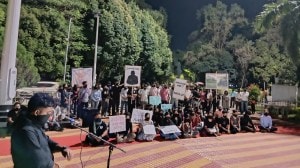Step by nuclear step
According to press reports, the parliamentary debate on the Indo-US nuclear deal was along predictable party lines...

According to press reports, the parliamentary debate on the Indo-US nuclear deal was along predictable party lines, except for two mystifying statements. One, by the prime minister that India’s fast breeder reactors will not be put under safeguards. And the other by the Leader of the Opposition that since the BJP does not like some sections of the Hyde Act, it will renegotiate the 123 agreement. Mystifying, because the former statement makes nonsense of the Indian insistence on the right to reprocess safeguarded spent fuel and the latter because the BJP’s likes and dislikes have no relevance to the operation of the Hyde Act which is a US law. Fortunately the debate does not appear to have touched upon the IAEA-India negotiations that can proceed as planned.
As per the decision of the joint UPA-Left committee, the IAEA agreement will not even be initialed, let alone signed before the committee examines the text of the agreement, with specific reference to the impact of the provisions of the Hyde Act and the 123 agreement on the safeguards agreement. In addition, presumably the committee will also examine how far the safeguards agreement incorporates the assurances given by the prime minister last year in Parliament.
The India-IAEA safeguards agreement will be based on INFCIRC/66/ Rev.2 which is applicable to countries that are not part of the NPT regime. All of India’s safeguards agreements with the IAEA have been on the basis of INFCIRC/66/Rev.2. With the almost universal membership of NPT, IAEA has in the recent past negotiated very few such safeguards agreements. In fact, of the three such agreements concluded by the IAEA in the past 20 years, two were with India — in 1988 and 1994 — and one with Pakistan in 2006.
As far as the IAEA is concerned, India is a Non Nuclear Weapon State (NNWS) under the NPT. In case of application of safeguards in NNWS party to the NPT, IAEA follows the comprehensive safeguards agreements given in INFCIRC/153 and applies safeguards on all peaceful nuclear activities within the territory of the state, under its jurisdiction or carried under its control. In addition, it has the authority to verify the absence of undeclared nuclear materials and activities in that state.
In case of India, even though India is a NNWS under NPT, the IAEA would expressly recognise the right of India to have undeclared nuclear material and activities, which may be engaged in the manufacture of nuclear explosives. Its rights and obligations under the India-specific safeguards agreement would be only for the purpose of verifying that the nuclear material subject to safeguards is not diverted to nuclear weapons or other nuclear explosive devices. The India-specific agreement would have no provision for withdrawal of such material for any non-peaceful activity. In all other respects, it will be similar to the voluntary safeguards agreement the IAEA has with the NPT defined NWS, which allow for withdrawal of such safeguarded material.
Therefore, the form of the agreement should not pose any problem. What about the other factors?
Hyde Act, 123, and safeguards agreement
While the Hyde Act has references to the IAEA and safeguards in a number of places, it is only Sec. 104(b)(2) that is of relevance in this context. This section requires that the safeguards agreement should apply safeguards in perpetuity on the civil nuclear facilities declared by India as well as requiring compliance with the IAEA Board of Governor’s Document GOV/1621.
The requirements of GOV/1621 are now part of all IAEA safeguards agreement. In fact, all IAEA-India safeguards agreements concluded after 1973 incorporate the requirements of GOV/1621, in particular the 1994 safeguards agreement in respect of Tarapur and the 1988 agreement in respect of Koodankulum. Therefore GOV/1621 does not pose any problem for India.
As for perpetuity, it could be in respect of either nuclear materials or facilities. Nuclear materials subject to IAEA safeguards are, one, all imported nuclear materials, and subsequent generation of nuclear materials as a result of the use of these imported nuclear material; two, nuclear material produced, processed or used in (a) an imported nuclear facility submitted to safeguards under a safeguards agreement by the parties to a bilateral or multilateral agreement and (b) nuclear facilities unilaterally submitted to safeguards under a safeguards agreement. The perpetual application of safeguards on nuclear materials subject to safeguards are covered by GOV/1621 and are part of all IAEA safeguards agreement, including the ones India concluded in respect of both the imported Koodankulum facility in 1988 and the voluntarily submitted Tarapur facility in 1994.
As for nuclear facilities, the application of safeguards in respect of nuclear materials produced, processed or used in a facility should be in conformity with either the bilateral/multilateral agreement under which the facility was imported or the terms under which the facility was voluntarily submitted for safeguards. Thus, for example, under the 1994 IAEA safeguards in respect of Tarapur, while the facility itself is under perpetual safeguards, only those “nuclear material supplied by any State to India for use in the Tarapur Atomic Power Station (TAPS) which material is required by the Supplier State to be subject to safeguards” shall be included in the inventory of nuclear materials subject to IAEA safeguards. In plain language, if India had chosen to run TAPS on indigenous enriched uranium, IAEA safeguards would not cover the spent fuel obtained as a result of such use even though the facility itself would be under safeguards!
Hence, depending on the final safeguards agreement, the use of the term ‘perpetual safeguards’ should not cause any alarm. There is no need, therefore, to apprehend any negative consequences as a result of the Hyde Act.
India’s objectives
What are the objectives that India needs to focus on while negotiating the IAEA safeguards agreement and the subsequent NSG amendments in respect of only the nuclear component of the deal?
One, imported reactors should not be held hostage to the vagaries or whims of fuel supplying nations. The right and obligations of both India and the fuel supplying nations should be well defined with adequate and assured arrangements for redressal of violations by either party.
Two, the operating environment of indigenous reactors declared in the list of civil nuclear facilities and put under perpetual IAEA safeguards should not be less favourable than would be obtained in the absence of a nuclear deal.
Three, in return for voluntary submission of indigenous reactors under perpetual safeguards, and the acceptance on Additional Protocol — not required by IAEA from the NNWS party to the NPT and subject to comprehensive safeguards — the operating environment of the indigenous reactors should be more favourable than would be obtained in the absence of a nuclear deal.
Can these objectives be obtained? Yes. But in all likelihood the Left In India would put roadblocks and on the basis of factors and objections of no relevance from the viewpoint of the above objectives may attempt to scuttle the IAEA safeguards agreement and the NSG negotiations. The final outcome will, therefore, depend much on the firm stand of the ruling coalition and government.
The writer is visiting fellow at IDSA and National Maritime Foundation balachandrangopalanhotmail.com
- 01
- 02
- 03
- 04
- 05































